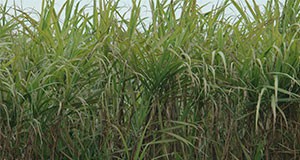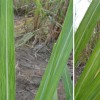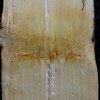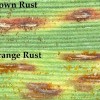 The production systems for sugarcane include either green cane or burnt cane harvesting operations. Sugarcane in Florida is typically harvested with burnt cane mechanical harvesting, but there is a growing interest to better understand the effects of green cane harvest residue “trash blankets” on microclimate conditions for sugarcane growing on both organic and mineral soils of Florida, so the authors conducted a three-year study to determine the effects of each harvest method on microclimate within the surface soil profile and at a 10 cm height from the soil surface. Results are presented in this 4-page fact sheet written by Hardev Sandhu, Maninder Singh, Robert Gilbert, Kelly Morgan, Ronald Rice, Leslie Baucum, James Shine Jr., and Mike Irey, and published by the UF Department of Agronomy, April 2015. (UF/IFAS Photo: Josh Wickham.)
The production systems for sugarcane include either green cane or burnt cane harvesting operations. Sugarcane in Florida is typically harvested with burnt cane mechanical harvesting, but there is a growing interest to better understand the effects of green cane harvest residue “trash blankets” on microclimate conditions for sugarcane growing on both organic and mineral soils of Florida, so the authors conducted a three-year study to determine the effects of each harvest method on microclimate within the surface soil profile and at a 10 cm height from the soil surface. Results are presented in this 4-page fact sheet written by Hardev Sandhu, Maninder Singh, Robert Gilbert, Kelly Morgan, Ronald Rice, Leslie Baucum, James Shine Jr., and Mike Irey, and published by the UF Department of Agronomy, April 2015. (UF/IFAS Photo: Josh Wickham.)
http://edis.ifas.ufl.edu/sc100
Tag: Robert Gilbert
Sugarcane Mosaic
 Mosaic’s most distinctive symptom is a pattern of contrasting shades of green, often islands of normal green on a background of paler green or yellowish chlorotic areas on the leaf blade. It had not been a problem in Florida until 1996, when it was observed on CP72-2086, a major commercial cultivar, near the intersection of Hatton Highway and US 98. Presently, because of the limited acreage of CP72-2086, the disease is only a potential threat. This 3-page fact sheet was written by P. Rott, J. C. Comstock, R. A. Gilbert, and H. S. Sandhu, and published by the UF Department of Agronomy, February 2015. (Photo: Philippe Rott, UF/IFAS)
Mosaic’s most distinctive symptom is a pattern of contrasting shades of green, often islands of normal green on a background of paler green or yellowish chlorotic areas on the leaf blade. It had not been a problem in Florida until 1996, when it was observed on CP72-2086, a major commercial cultivar, near the intersection of Hatton Highway and US 98. Presently, because of the limited acreage of CP72-2086, the disease is only a potential threat. This 3-page fact sheet was written by P. Rott, J. C. Comstock, R. A. Gilbert, and H. S. Sandhu, and published by the UF Department of Agronomy, February 2015. (Photo: Philippe Rott, UF/IFAS)
http://edis.ifas.ufl.edu/sc009
Sugarcane Ratoon Stunting
 Ratoon stunting, also known as ratoon stunting disease (RSD), is considered by many sugarcane pathologists to be the most important disease affecting sugarcane production worldwide, because it can cause 5% to 15% crop yield losses without growers even realizing their fields are infected. This 3-page fact sheet describes the symptoms, causal agent, and prevention and control. Written by P. Rott, S. Sood, J. C. Comstock, R. A. Gilbert, and H. S. Sandhu, and published by the UF Department of Agronomy, August 2014. (Photo credit: Sushma Sood, USDA)
Ratoon stunting, also known as ratoon stunting disease (RSD), is considered by many sugarcane pathologists to be the most important disease affecting sugarcane production worldwide, because it can cause 5% to 15% crop yield losses without growers even realizing their fields are infected. This 3-page fact sheet describes the symptoms, causal agent, and prevention and control. Written by P. Rott, S. Sood, J. C. Comstock, R. A. Gilbert, and H. S. Sandhu, and published by the UF Department of Agronomy, August 2014. (Photo credit: Sushma Sood, USDA)
http://edis.ifas.ufl.edu/sc002
Sugarcane Orange Rust
 In June 2007, rust symptoms were observed on sugarcane cultivar CP80-1743 about six miles east of Belle Glade, Florida. The disease was confirmed as orange rust of sugarcane. It is hypothesized that rust spores were blown into the region as a disperse spore cloud from an unknown source rather than spread from a single or several small focal points. This 7-page fact sheet was written by P. Rott, S. Sood, J. C. Comstock, R. N. Raid, N. C. Glynn, R. A. Gilbert, and H. S. Sandhu, and published by the UF Department of Agronomy, May 2014.
In June 2007, rust symptoms were observed on sugarcane cultivar CP80-1743 about six miles east of Belle Glade, Florida. The disease was confirmed as orange rust of sugarcane. It is hypothesized that rust spores were blown into the region as a disperse spore cloud from an unknown source rather than spread from a single or several small focal points. This 7-page fact sheet was written by P. Rott, S. Sood, J. C. Comstock, R. N. Raid, N. C. Glynn, R. A. Gilbert, and H. S. Sandhu, and published by the UF Department of Agronomy, May 2014.
http://edis.ifas.ufl.edu/sc099
Sugarcane Ripeners in Florida (SSAGR215/SC015)
 Ripeners can be incorporated as an important component of sugarcane production management strategy. This 2-page fact sheet was written by D. C. Odero, C. R. Rainbolt, R. A. Gilbert, and J. A. Dusky, and published by the UF Department of Agronomy, October 2011. Photo by ruumo/CC BY-SA 2.0
Ripeners can be incorporated as an important component of sugarcane production management strategy. This 2-page fact sheet was written by D. C. Odero, C. R. Rainbolt, R. A. Gilbert, and J. A. Dusky, and published by the UF Department of Agronomy, October 2011. Photo by ruumo/CC BY-SA 2.0
http://edis.ifas.ufl.edu/sc015
Production of Giant Reed for Biofuel (SSAGR318/AG327)
 Giant reed is currently being evaluated as a potential biomass energy crop in Florida, even though some scientists and those in other states consider it to be a noxious or invasive weed. This 4-page fact sheet discusses the adaptation and production of giant reed as a potential energy crop and presents measures for controlling giant reed as an escaped weed. It does not give specific recommendations on whether it is better to control giant reed or produce it for biofuel. Written by Dennis Odero, Robert Gilbert, Jason Ferrell, and Zane Helsel, and published by the UF Department of Agronomy, November 2011.
Giant reed is currently being evaluated as a potential biomass energy crop in Florida, even though some scientists and those in other states consider it to be a noxious or invasive weed. This 4-page fact sheet discusses the adaptation and production of giant reed as a potential energy crop and presents measures for controlling giant reed as an escaped weed. It does not give specific recommendations on whether it is better to control giant reed or produce it for biofuel. Written by Dennis Odero, Robert Gilbert, Jason Ferrell, and Zane Helsel, and published by the UF Department of Agronomy, November 2011.
http://edis.ifas.ufl.edu/ag327
SS-AGR-228/SC028 Nutritional Requirements for Florida Sugarcane
Revised! SS-AGR-228, an 8-page fact sheet by R. W. Rice, R. A. Gilbert and J. M. MCray, provides an overview of plant nutrition, with general guidelines and deficiency symptoms for each nutrient for sugarcane production in Florida. Includes references. Published by the UF Department of Agronomy, December 2009.
http://edis.ifas.ufl.edu/sc028
SL295/SS508 Review of Current Sugarcane Fertilizer Recommendations: A Report from the UF/IFAS Sugarcane Fertilizer Standards Task Force
SL-295, a 6-page report by K.T. Morgan, J.M. McCray, R.W. Rice, R.A. Gilbert and L.E. Baucum, reports the findings of a task force of Florida agronomists and soil scientists, agents and local grower representatives. It includes a review of the current fertilizer recommendations for sugarcane, a review of recent sugarcane fertilizer research, and an assessment of the gaps and recommended research priorities. Published by the UF Department of Soil and Water Science, July 2009.
http://edis.ifas.ufl.edu/SS508
SS-AGR-318/AG327 Production of Giant Reedgrass for Biofuel
SS-AGR-318, a 4-page illustrated fact sheet by Robert Gilbert, Jason Ferrell, and Zane Helsel, discusses the adaptation and production of Arundo as a potential energy crop and presents measures for controlling Arundo as an escaped weed, based on initial observations in preliminary university trials and cited literature. Includes references. Published by the UF Department of Agronomy, November 2008.
http://edis.ifas.ufl.edu/AG327